
Annibal was a 74-gun ship of the line of the French Navy, lead ship of her class. She was designed by Jacques-Noël Sané, and was one of the earliest of his works. She was built at Brest in 1778.

Count Toussaint-Guillaume Picquet de la Motte, also known as La Motte-Picquet was a French Navy officer and admiral. Over a career spanning 50 years, he served under Louis XV and Louis XVI and took part in 34 campaigns. He fought in the Seven Years' War and in the Naval battles of the American Revolutionary War, earning the ranks of Commandeur in the Order of Saint Louis in 1780, and of Grand Cross in 1784. He died during the French Revolution.

Héros was a 74-gun ship of the line of the French Navy, known mostly for being the flagship of Pierre André de Suffren de Saint Tropez during the Anglo-French War.

Artésien ('Artesian') was a 64-gun ship of the line of the French Navy, lead ship of her class. She was funded by a don des vaisseaux donation from the Estates of Artois.
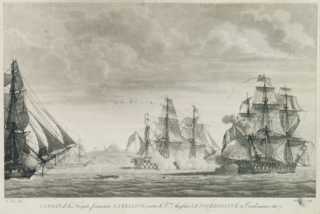
Bellone was an Iphigénie-class 32-gun frigate of the French Navy on plans by Léon-Michel Guignace. She took part in the American Revolutionary War in the Indian Ocean with the squadron under Suffren, and later in the French Revolutionary Wars. She was present at the Glorious First of June.
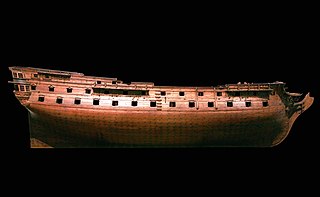
The Vengeur was a 64-gun ship of the line of the French Navy designed by Antoine Groignard. She saw action with Bailli de Suffren during the American War of Independence.

Admiral comte Pierre André de Suffren de Saint Tropez, bailli de Suffren, Château de Saint-Cannat) was a French Navy officer and admiral. Beginning his career during the War of the Austrian Succession, he fought in the Seven Years' War, where he was taken prisoner at the Battle of Lagos. Promoted to captain in 1772, he was one of the aids of Admiral d'Estaing during the Naval battles of the American Revolutionary War, notably taking part in the Siege of Savannah.
Pierre Servan René Bouvet de Maisonneuve was a French naval officer. He served in several notable battles, notably the action of 17 June 1778, and the battles conducted by Suffren in the Indian Ocean. He was wounded at the Battle of Porto Praya. He was the father of Pierre François Étienne Bouvet de Maisonneuve.
Ajax was a 64-gun ship of the line of the French Navy.
Sévère was a 64-gun ship of the line of the French Navy.
Saint Michel was a 64-gun ship of the line of the French Navy, lead ship of her class.
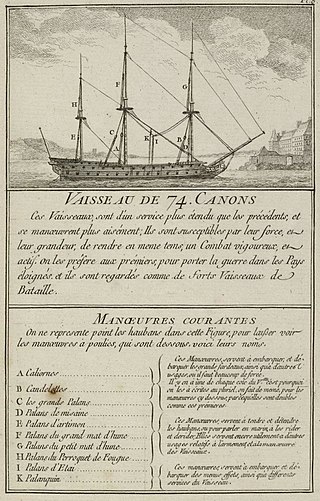
Palmier was a 74-gun ship of the line of the French Navy.
HMS Fortune was a British 14-gun sloop launched in 1778 that the French captured in April 1780. She then served with the French navy under the same name.
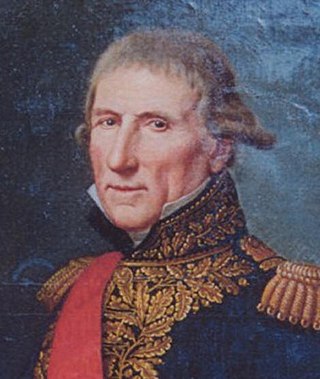
Armand de Saint-Félix was a French Navy officer and admiral.
Louis-Hyacinte de Cavelier, chevalier de Cuverville was a French Navy officer.
Charles Louis du Chilleau de La Roche was a French Navy officer.
Louis-Esprit d'Aymar was a French Navy officer. He fought in the Indian Ocean under Suffren during the War of American Independence, captaining the 64-gun Saint Michel at the Battle of Trincomalee from 25 August to 3 September 1782, and the 74-gun Annibal at the Battle of Cuddalore on 20 June 1783.
Naïade was a 20-gun Coquette-class corvette. She took part in the Indian theatre of the Anglo-French War with the squadron under Suffren. The British Royal Navy captured her in 1783 but never commissioned her; it sold her in 1784.
Brillant was a 64-gun ship of the line of the French Navy. She was first classified as a Second-rank ship, and later reclassified as a Third-rank. She was built between 1689 and 1690 at Le Havre, under supervision by engineer Étienne Salicon. She served until 1719, and took part in the Nine Years' War (1688–1697) and the War of Spanish Succession (1702–1714).
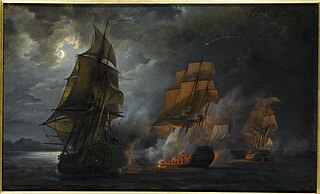
Triton was a 64-gun ship of the line of the French Navy designed by François Coulomb the Younger. She took part in the Seven Years' War and in the War of American Independence.











